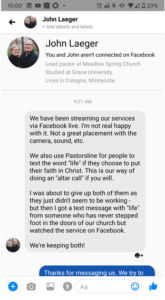
Outreach, crusades, and going beyond-the-walls are all concepts many of us are familiar with. We understand our commission stated in Matt 28:19. In essence, it’s “evangelism”. It’s reaching people for Christ using the contemporary tools available and a GO approach vs a “let’s wait until they come” attitude.
If that’s true, then digital evangelism is exactly the same.
Digital Evangelism is evangelism using digital tools and a digital strategy to drive people from online (broadcast) to offline (baptism).
In this concept, the broadcast can be your live-streamed sermons, archived content on your website or simply your consistent posting on social media. The “Baptism” represents a conversion commitment in one form or another.
What is involved in that exactly? In the examples below, we see two different ministries using a digital strategy we shared with them-video and texting to get people from comments and ‘likes’ to actually committing to Christ.
Digital Ministry – Online to Offline
Texan family man, Mark Andrew Fox is a pastor, director, and evangelist. An alumnus of Andrews University and Andrews Theological Seminary, Fox is now involved with Forever Free Ministries and the YouTube channel, “Amazing Prophecies”. Fox’s ministry is online by design but faced a unique challenge.
Fox’s YouTube channel excelled in creating engaging content and following the best practices of YouTubing. It was a bonus that Mark is a prolific speaker on and off camera and has had years of experience creating content. One of his videos has over 1 million views. So creating content wasn’t his challenge.
However, as a seasoned evangelist, Mark’s end goal was how do you go from broadcast to baptism?
He had tons of engagement-likes, subscriptions to his channel, and comments-but needed a way to connect those who were viewing online. Many were saying they wanted to be baptized, but there wasn’t a clean way for him to quickly and effectively know who’s who and how to get in contact with them.
He tried contacting his viewers online directly via YouTube, adding them to FB and contacting that way.
These methods weren’t bringing the results Mark wanted.
Adding texting
I first connected with Mark when he visited a local church to run an outreach event and then again a few years later at a conference. I saw what he was doing and was impressed with his progress. I offered to work with his ministry on some of his challenges.
I wasn’t sure if texting was going to work with a YouTube audience, so we piloted it. The text messaging was the way to capture the users’ data and drive people to the next step-a process we designed.
See the picture showing how he used it.

A message pops in at the top right, “TEXT PRAYER TO (940) 222-44**”. This simple opt-in is actually a powerful funnel, turning anonymous ‘Likes’ and ‘Who-knows-if-its-their-real-name’ comments into actual people who become part of a database for later follow-up.
The results
To date, Mark has thousands of names, addresses, and matching cell phones in his database. He can then send them his ministry magazines and notices for special, live, online, streaming events. But the biggest win reported a few months after he launched this simple strategy, were two confirmed local baptisms at local churches of people whom he has never met but directly related to viewing his content.
So you might be wondering whether this can apply to a church with a local presence and what does that look like?
Physical Church – Online to Offline
John Laeger is the Founding and Lead Pastor at Meadow Spring Church in Minnesota.
He shared the following story.

The Church Setup
John and his team were “streaming services via Facebook live“. They weren’t “real happy about it” because there wasn’t “a great placement with the camera, sound, etc.”.
Meadow Spring Church also uses “PastorLine for people to text the word ‘life’ if they choose to put their faith in Christ. This is our way of doing an ‘altar call’ if you will.”
The Results
John said, “I was about to give up both of them as they just didn’t seem to be working-but then I got a text message with ‘life’ from someone who has never stepped foot in the door of our church but watched the service on Facebook.”
The Conclusion
“We’re keeping both!” John told us.
As you can see, it really doesn’t matter who does digital evangelism, and it’s not as complicated as you think.
Most churches are already creating content. Why not add a simple digital strategy and tools to bring more people from online to offline?
And there is more.
With digital tools like texting, you can add automation so you not only capture the potential guest’s information, but you can also send follow-up messages and even polls to ensure that guests take action. It might be to join an online group or to plan a visit like Mike L. did.
So not only are you making a connection and capturing their information, you can communicate, then potentially convert that person to join your or another local church.
How long will it take to get lost sheep back into the fold? How much time will it take between the planting of the seed and the harvest?
We can’t give you a definite answer but here’s what we do know: the churches which follow a strategy and are consistent see results at some point. At the minimum, you now have the proper data to know if something doesn’t work, why, and how to change it. It may not require you to abandon your entire strategy. You may need to just tweak it or change the digital tools you are using.
Is your church ready to seriously work on rounding up the virtual lost sheep and guiding them to ‘baptism’?
Yes, take me to the free, $0 for 30 days trial.
Not yet, but I’d like to know more about texting in churches.



